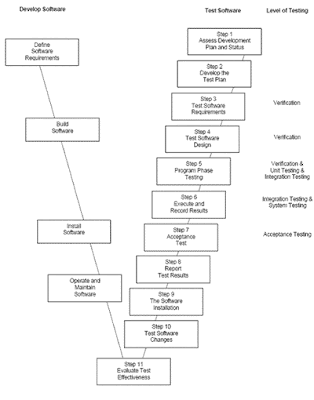
The V-Concept of Testing - Points to Ponder on Agile
1.Cost/Schedule Impact – Agile does NOT have a cost/schedule advantage over a typical waterfall model, assuming that the requirements remain stable over the duration of the project. Where Agile makes a difference is Iterative development addresses the impact of changing requirements far better than waterfall. Reduces the risk of severe defects during customer review by having multiple iterations and getting continuous feedback from the customer. Continuous integration and validation mean that defect fixes and minor requirement changes during development can be accommodated within the iteration. 2. Iterative Development – Split the dev phase into multiple iterations, depending on the total effort and risk of application Given our resource situation, iterations should ideally not be more than 8-12 weeks The first iteration while focusing on the framework and infrastructure components should include at least some UI intensive scenarios, to facilitate early feedback from the client.3. Development focus Test-driven design and programming – Agile depends heavily on the premise that the developed code is well-tested. The programmers should write code that is easily testable from an object oriented perspective. Automated and Complete Unit Testing – Code coming out of the developer’s workshop should have undergone complete unit testing amounting to 100% of achievable code coverage (who certifies this?). Emphasis is also put on an automated unit test framework, so that multiple iterations can be executed with minimal additional effort. Whenever a new code unit is tested, test previously released units as a sort of regression. Pair Programming – Can be explored based on cost & availability of skilled resources.
4. Continuous Integration Frequent incremental integration as opposed to big bang integration.i. Eliminates high risk integration issues which may lie hidden till the end in a big bang integration scenarioii. Quick turn around time for integration defects – dev or testing is not held up for long periods. Unit Tested Code – Only 100% unit tested code qualifies for continuous integration. Any integration issues should NOT be due to code defects missed during unit testing Frequency – Varies depending on the maturity of team, complexity of requirements, % of UI component in application etc. In our scenario, the recommended target would be at least two integrations a week, after the initial build on the integration box. Validation – Each of the cone integrations shall be smoke tested, and milestones shall be system tested.
window.google_render_ad();
5. Integration Team – A small team of developers will work closely with QA for managing the continuous integration process, and for test support. The responsibilities of the team will be Controlling the contents of each integration Sorting out integration issues Fixing defects found during testing.6. Testing – Agile relies heavily on “nipping defects in the bud”. Agile does not define a single, intensive integration testing phase, for the simple reason that there is no “integration phase”. How do we validate the continuously integrated build then? – Using the system test plan instead, to test minor milestonesi. Milestones – Define milestones that comprise of a small number of related functionalities, which can be tested independently. Ideally the cone integrations and milestones should be planned in such a way that every three or four cone integrations should add up to a milestone.ii. The system test plan for a milestone should be prepared and reviewed at all levels before the milestone is reached.iii. At the end of 2 or 3 milestones, do a full regression of the previous milestones. Defect fixes – Fixes for defects encountered during the system testing should be fixed during the integration for the next milestone, before a lot more functionality gets added on top of the buggy code. This ensures that by the time the application (or the iteration) reaches QA, the number of defects is minimal.
7. QA Involvement – QA Team gets involved from requirements phase itself An experienced QA resource shall be involved during initial requirements gathering and take control of requirement management from the QA side. From the end of the initial requirements phase, the QA plan preparation will go hand in hand with design. The QA plan should be granular in the extreme, containing all of the system or integration test scenarios in detail. QA will be responsible for validation the milestones during continuous integration.8. Team Composition – notes The dev team should aim for at least 50% mix of J2EE resources with quality experience in executing web projects, and usage of tools identified. The QA team should have 50% of its resources well experienced in requirements handling, preparation and management of QA plan from requirements/design, and Agile Testing processes.